When we checked in the desk clerk told us breakfast was not included in our room rate, and we could eat upstairs for 8E. Considering the average price of food in Greece this is ridiculous, but it was so much easier than trying to venture out to find food that we did. I had hoped for 8E that the breakfast would be substantial with maybe a few hot dishes. Ha! It was standard Greek-style continental, with yogurt, honey, jam, cheese, ham, tomato, cucumber, cereal flakes, and some very bad baked goods (bread and mini chocolate croissants). Unquestionably not worth 8E.
There was no water out, only the orange "juice" so I had to ask for some. I felt very uncomfortable because when we had walked in one of the workers (white European, but not Greek) had been talking to the other workers (African) about how un-prejudiced she was from an early age and how everyone had always had a problem with that. She said that Americans were probably racist, *knowing* we were American as we had already spoken to exchange good morning pleasantries.
For some reason, this really really upset me, even though I know that generally the people who feel the need to loudly proclaim how un-racist they are usually end up being very racist indeed. If they really saw no division among people, they wouldn't be talking about race but about the weather or current events. And I'm sure she was making the African women uncomfortable because what were they supposed to do, congratulate her? Thank and admire her? (And by the way, expecting some sort of reverence because of your "benevolence" toward someone of another race is pretty much racist.) Anyway, all this made me feel racist for asking one of them to get me some water because I really couldn't drink that orange stuff and I like to start off my day hydrated. The next morning I brought a bottle of water up with me.
We had bought our 12E combined ticket the day before. It allows entrance to the Acropolis, Hadrian's Library, and five additional sites: The Theater of Dionysius, the Temple of Olympian Zeus, the Ancient Agora, the Karameiko, and the Roman Agora. We were determined to collect 'em all.
 First stop, The Acropolis! There were hundreds of people there so you end up with pictures like this. I love the woman pointing. She's all, "Hey! There's the Parthenon!" and the woman next to her is all, "Hot damn, I believe you're right!" (Click on the pic to enlarge if you are having trouble seeing this tableau.) And indeed, there it was. Most of the guidebooks recommend buying your combined ticket at one of the "lesser" sites to avoid the lines at the Acropolis ticket booth. We already had ours, but really the ticket booth lines didn't seem too long.
First stop, The Acropolis! There were hundreds of people there so you end up with pictures like this. I love the woman pointing. She's all, "Hey! There's the Parthenon!" and the woman next to her is all, "Hot damn, I believe you're right!" (Click on the pic to enlarge if you are having trouble seeing this tableau.) And indeed, there it was. Most of the guidebooks recommend buying your combined ticket at one of the "lesser" sites to avoid the lines at the Acropolis ticket booth. We already had ours, but really the ticket booth lines didn't seem too long. 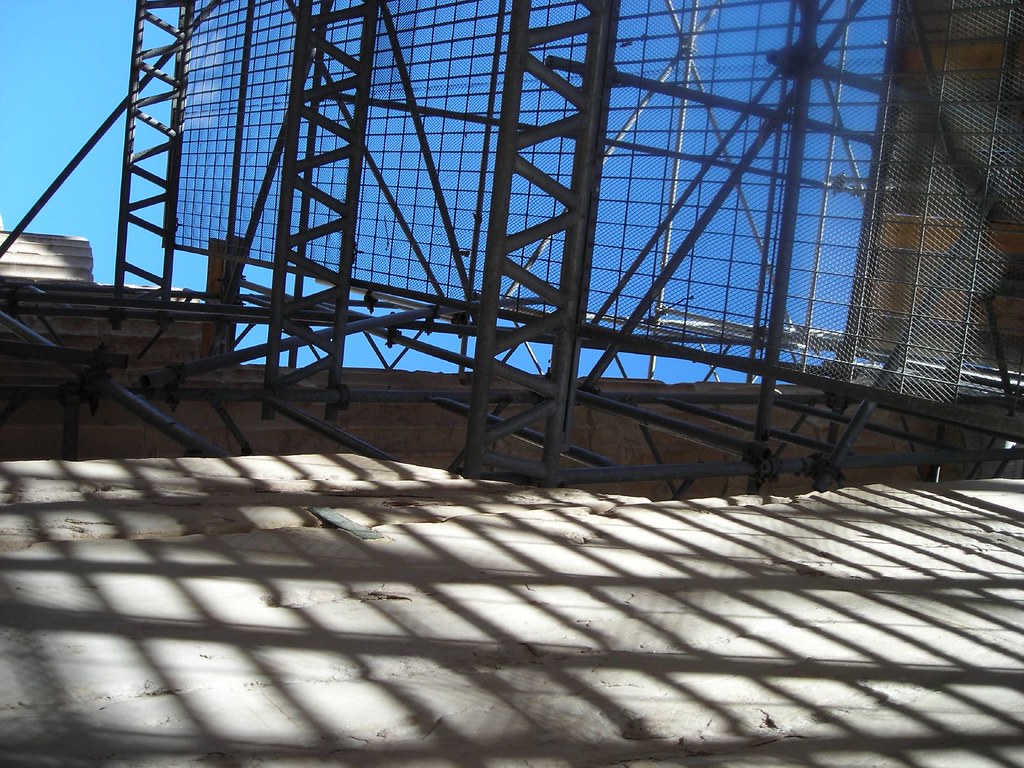 There's a lot of scaffolding about so that sort of interferes with the romantic effect of of the photos. It did make for some good photos itself, though, or at least I like this shot of the Propylaia. If scaffolding is what it takes to keep the sites going, I'm willing to have some unromantic pictures from my vacation!
There's a lot of scaffolding about so that sort of interferes with the romantic effect of of the photos. It did make for some good photos itself, though, or at least I like this shot of the Propylaia. If scaffolding is what it takes to keep the sites going, I'm willing to have some unromantic pictures from my vacation!On the Acropolis we were glad to have the Eyewitness guidebook, because when we were entering by way of the Propylaia and wondering what in the world we were looking at we just looked for a picture of what we were facing and voila. I had bought the Eyewitness guide for the Greek mainland, and for Athens I took the Eyewitness Top 10 Athens out of the library. It is a genius book. It gives top 10 sites, top 10 museums, top 10 things to do, and then for the major sites it gives more top 10 lists, Acropolis, Archeaological Museum, Agora, etc. This is fast food tourism at its finest, and we loved it. There is way too much to see, and unless you are a student of archaeology and/or have a month to spend in Athens, having *some* way to prioritize things is a must. K also had her more in-depth Lonely Planet guide which we appreciated for its more detailed information.
You enter by stone stairs that go up through the Propylaia. This is where the crowds were most evident, as the stairs can hold only a finite amount of people so there's a lot of shuffling going on. It was a little worrisome because all it takes is one person to stumble and the whole lot will go down like dominos. As the site is so well-visited there are slick spots. We had a dry day so nobody slipped on the stairs. Once you push through the Propylaia you can spread out on the site.
The Temple of Athena Nike was taken down and transported offsite for conservation (and, like everything else, was to have been completed before the Olympics but is still MIA), so we missed that. Ditto all the objects in the museum. We missed the opening of the new Acropolis museum by three weeks. The whole time we were there they were erecting a ton of little booths on the pedestrian walk that I assume had something to do with the museum opening.
I wonder if England will return the "Elgin" marbles (quotes intentional, as the name is deliberately chosen to obscure their origin) once the museum opens? I understand they feel they acquired them from Lord Elgin fair and square, but they are one of the greatest Greek national treasures and I feel it is unconscionable to keep them. The excuse has always been that Greece cannot properly care for and display them; the new museum was built partly as a response to that and will have an empty room awaiting their return. I saw them when I was last in London and while they are well-displayed, it just not the same to have them in a room in the middle of a building as it would to have them in the new glass-walled Acropolis museum.
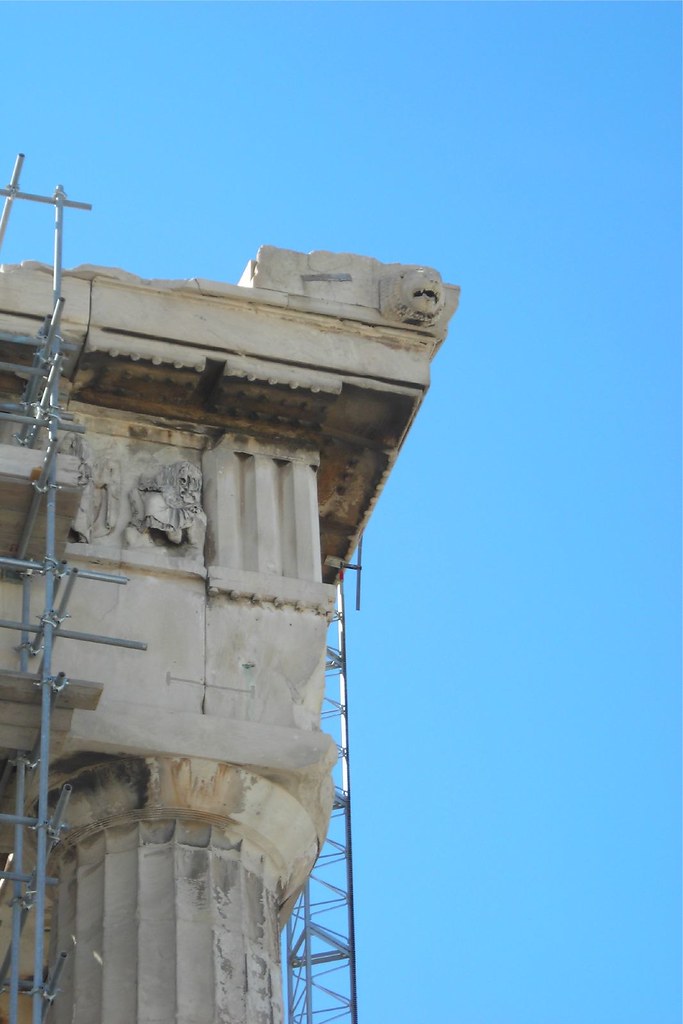 The Parthenon is covered in scaffolding and really there were so many people around it that it was hard to get a good long look at the details. There were a few things that struck me, though. I especially loved the lion head waterspouts on the roof. Generally, it's just amazing that it has been standing for so long! The Parthenon is a marvel of architecture because the lines of the columns that appear so perfectly straight are actually not. The columns were designed with a slight curvature, which corrected what the eye would see as an assymetry if the pillars had been perfectly straight pillars. How you figure that out without a computer I can't imagine. Well, I couldn't do it even with a computer.
The Parthenon is covered in scaffolding and really there were so many people around it that it was hard to get a good long look at the details. There were a few things that struck me, though. I especially loved the lion head waterspouts on the roof. Generally, it's just amazing that it has been standing for so long! The Parthenon is a marvel of architecture because the lines of the columns that appear so perfectly straight are actually not. The columns were designed with a slight curvature, which corrected what the eye would see as an assymetry if the pillars had been perfectly straight pillars. How you figure that out without a computer I can't imagine. Well, I couldn't do it even with a computer.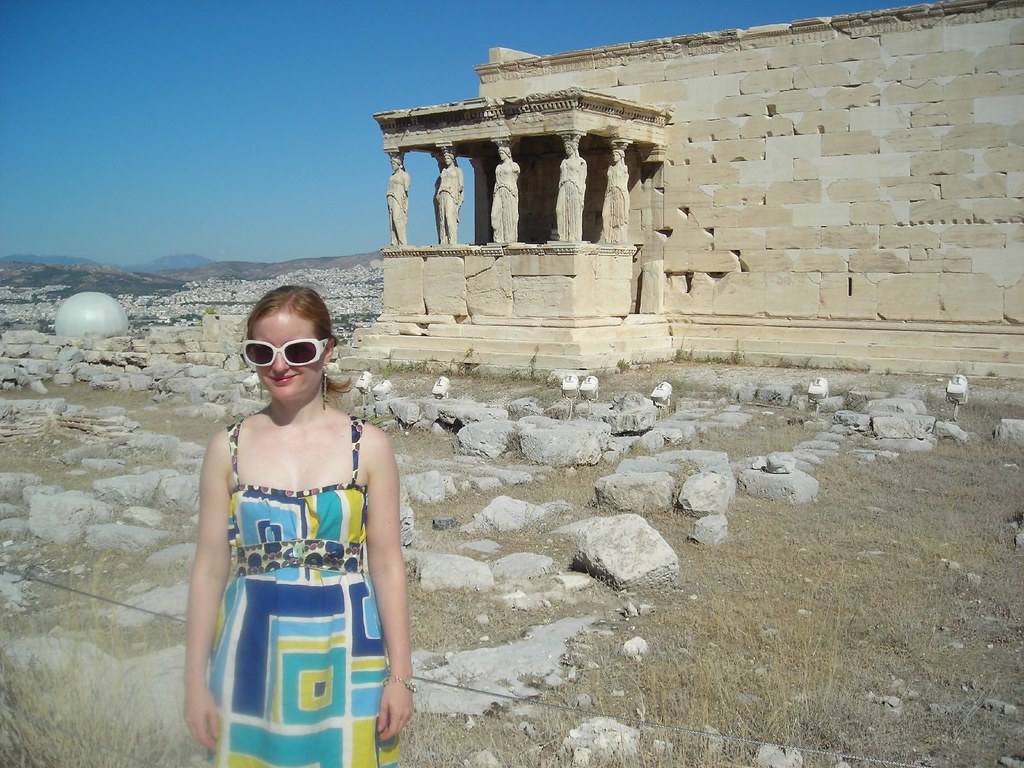 My favorite place on the Acropolis was the Erechtheion. The most striking feature, of course, are the Caryatids. The ones on the temple are casts of the originals, which are housed in the museum (save the one chiseled out and hauled away by Elgin). I'd prefer conservation over authenticity so that's fine with me. The building is remarkable because its four faces are on three different levels, which is a major architectural and engineering feat. Its placement was careful and deliberate because the footprint had to avoid a lot of sacred sites.
My favorite place on the Acropolis was the Erechtheion. The most striking feature, of course, are the Caryatids. The ones on the temple are casts of the originals, which are housed in the museum (save the one chiseled out and hauled away by Elgin). I'd prefer conservation over authenticity so that's fine with me. The building is remarkable because its four faces are on three different levels, which is a major architectural and engineering feat. Its placement was careful and deliberate because the footprint had to avoid a lot of sacred sites.  In one corner grows an olive tree, in the spot where Athena presented it as her gift to the city. An olive tree is way better than salt water (that Poseidon was such a one trick pony!) so Athens was named after Athena. The Greek name of the city is actually "Athina"--not a derivation, her actual name.
In one corner grows an olive tree, in the spot where Athena presented it as her gift to the city. An olive tree is way better than salt water (that Poseidon was such a one trick pony!) so Athens was named after Athena. The Greek name of the city is actually "Athina"--not a derivation, her actual name.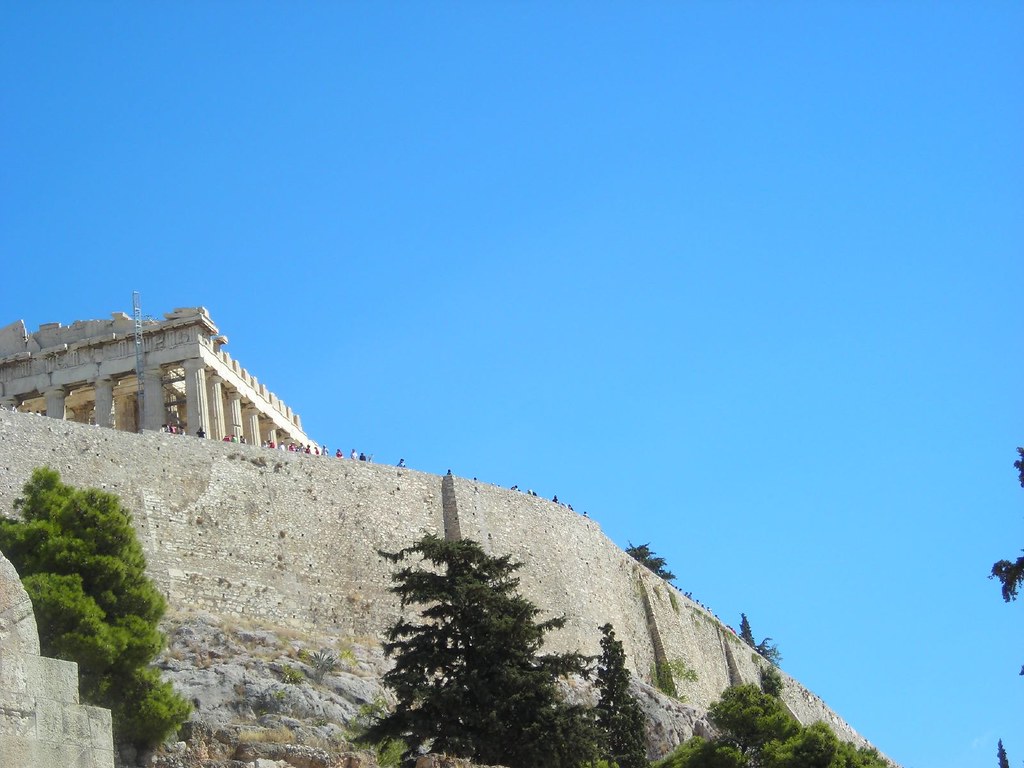 The Acropolis was built on the tallest hill in Athens, so there is an amazing 360 view of the city. When we came back down from it I enjoyed looking up to see all the people leaning over the wall to view the city spread out below them. You also get nice views up there of the Temple of Olympian Zeus and the Temple of Hephaestos in the Agora, which is the most intact temple of its type.
The Acropolis was built on the tallest hill in Athens, so there is an amazing 360 view of the city. When we came back down from it I enjoyed looking up to see all the people leaning over the wall to view the city spread out below them. You also get nice views up there of the Temple of Olympian Zeus and the Temple of Hephaestos in the Agora, which is the most intact temple of its type. On the hill of the Acropolis but a separate site and a separate tab on your combined ticket is the Theater of Dionysius. I had been having some photo op envy because in Thessaloniki K had me take her picture sitting in the theater at the Roman Forum, and I was regretting not having done the same. I was worried as it looked like all the seating at Dionysius was roped off, but no! I got my shot. The friezes along the back of the stage (when you're facing the stage) are remarkably intact, though most are headless.
On the hill of the Acropolis but a separate site and a separate tab on your combined ticket is the Theater of Dionysius. I had been having some photo op envy because in Thessaloniki K had me take her picture sitting in the theater at the Roman Forum, and I was regretting not having done the same. I was worried as it looked like all the seating at Dionysius was roped off, but no! I got my shot. The friezes along the back of the stage (when you're facing the stage) are remarkably intact, though most are headless. 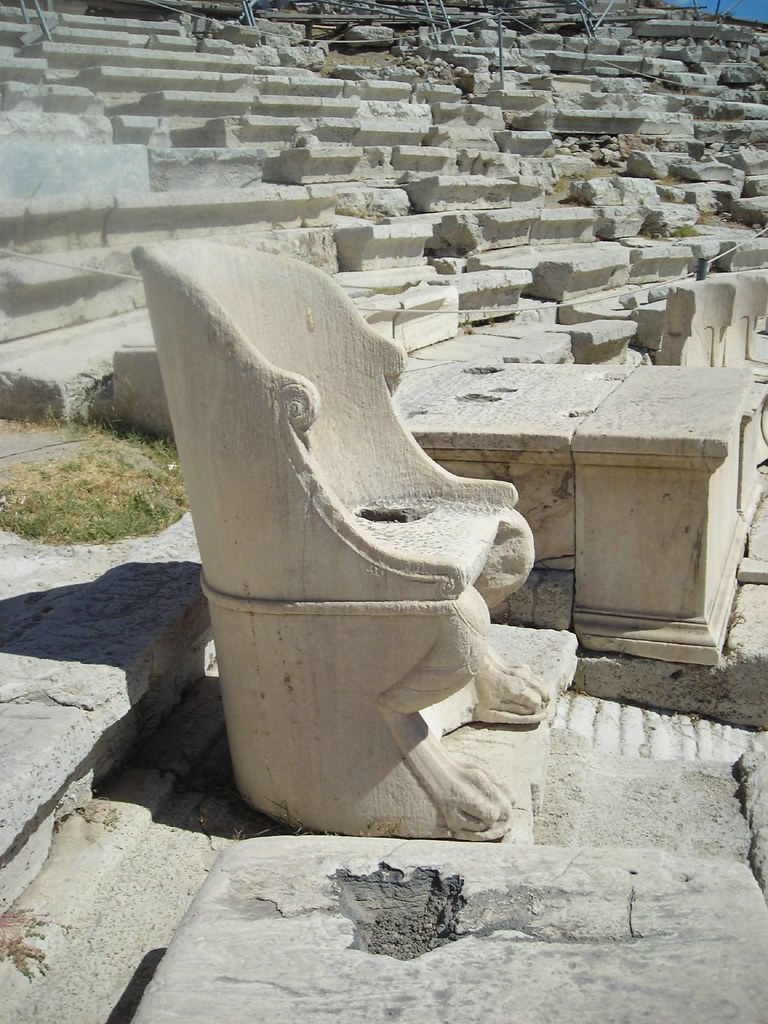 While important priests had clawfoot marble thrones for the performances, women were consigned to the nosebleed section. The seating has deteriorated and disappeared as high up as all that, but it's possible to hike up there. I hope the actors had strong lungs. From the top of your climb you can see a niche in the stone face, where there was an ancient shrine (hard to find good information on it--one source says Dionysius was honored there, but the decoration is Artemis and Apollo slaying the children of Niobe) and then later a church to the Virgin of the Golden Cave. It is currently closed, though we could see that an icon of Mary is maintained in the cave.
While important priests had clawfoot marble thrones for the performances, women were consigned to the nosebleed section. The seating has deteriorated and disappeared as high up as all that, but it's possible to hike up there. I hope the actors had strong lungs. From the top of your climb you can see a niche in the stone face, where there was an ancient shrine (hard to find good information on it--one source says Dionysius was honored there, but the decoration is Artemis and Apollo slaying the children of Niobe) and then later a church to the Virgin of the Golden Cave. It is currently closed, though we could see that an icon of Mary is maintained in the cave.It was a sunny, warm-almost-hot day and although before we set out from the hotel K had liberally applied her 25 SPF sunscreen (the highest SPF you can find in Europe) and was waering a hat, she was beginning to sizzle. I hadn't realized she had only 25 SPF and therefore hadn't offered her any of my 50 SPF with titanium dioxide (I don't mess around) in the morning. We stopped back at the hotel so she could put some on and I reapplied. I cannot stress enough the importance of good sunscreen! *Everyone* at the Acropolis was reddening except me, it seemed. The sun was strong and perhaps the ozone was thin that day, who knows. I also found a hat to be essential, particularly that day and on our visit to Delphi. All right, dermatologic lecture over.
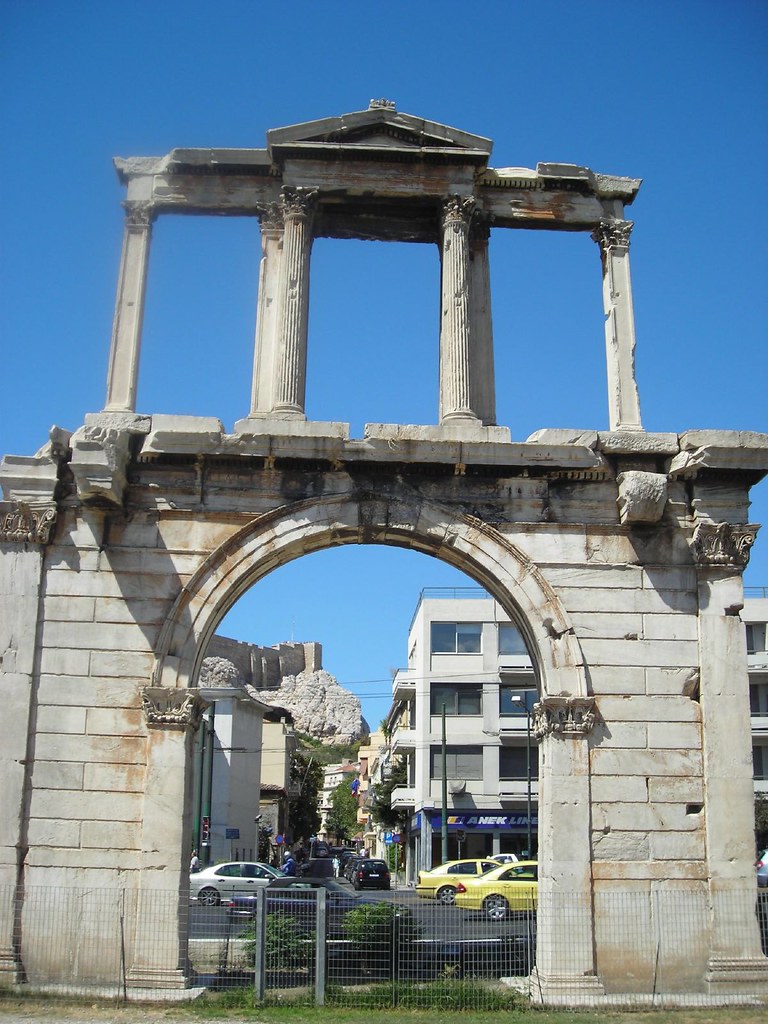 Next stop, the Temple of Olympian Zeus. Zeus had been our nemesis the day before. Everytime we got lost we found ourselves back at Zeus. We couldn't escape. The upside is that when we were heading for him deliberately we got there easily. Right outside, and no admission required, is Hadrian's Gate, with its famous double inscription. The side facing the Acropolis says "This is Athens, the ancient city of Theseus," Theseus being a famed mythical king, or at least a famed king of mythical exploits. The other says, "This is the city of Hadrian, and not of Theseus." Well then. Hadrian's inscription faced the new modern city. Now both sides face plenty of modernity!
Next stop, the Temple of Olympian Zeus. Zeus had been our nemesis the day before. Everytime we got lost we found ourselves back at Zeus. We couldn't escape. The upside is that when we were heading for him deliberately we got there easily. Right outside, and no admission required, is Hadrian's Gate, with its famous double inscription. The side facing the Acropolis says "This is Athens, the ancient city of Theseus," Theseus being a famed mythical king, or at least a famed king of mythical exploits. The other says, "This is the city of Hadrian, and not of Theseus." Well then. Hadrian's inscription faced the new modern city. Now both sides face plenty of modernity!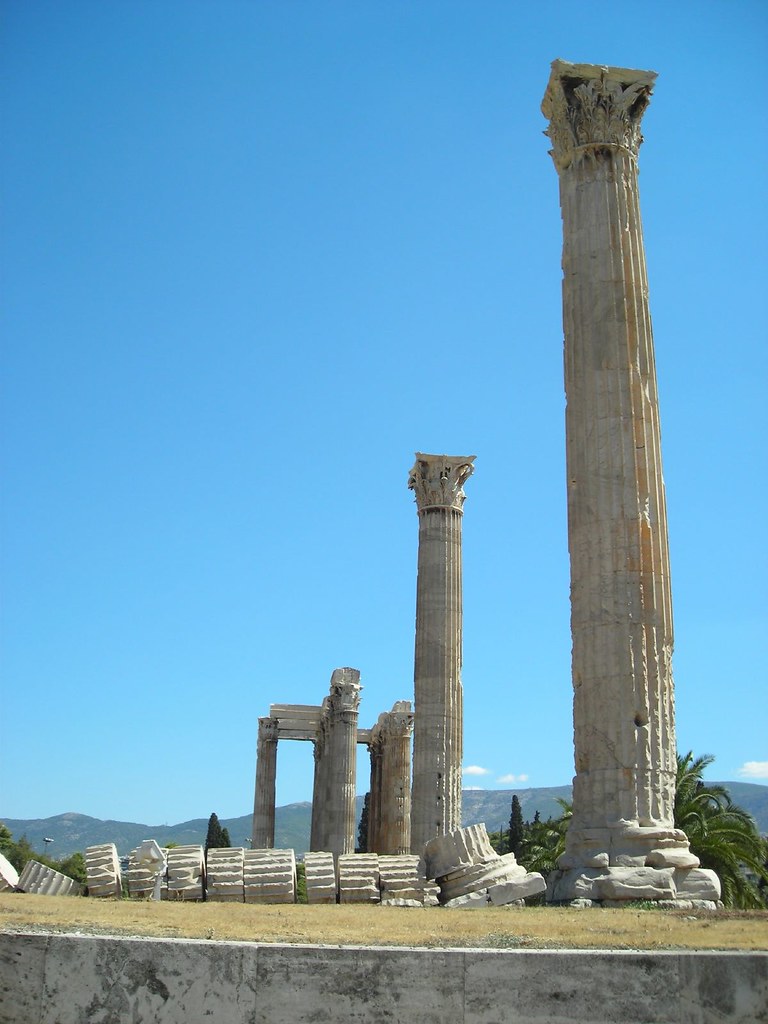 The Temple of Olympian Zeus does require a tab to be pulled off your combined ticket--but they didn't pull ours. At one time 104 elaborate and stately Corinthian columns supported the temple; sixteen (some sources say 15; I didn't count) remain standing. The most recent loss blew down in a heavy wind--a really heavy wind given the size and weight of the things--in 1852. It was left to lay where it fell, which gives a nice poetic feel to the site. Because it's what I do I visited the restroom. It is placed off in a corner and grand marble steps lead down to the marble-floored loo. It has what I call an Italian toilet (no seat--I really wonder where all the toilet seats of Italy went), but was clean and well-equipped with toilet paper and soap. There are ruins of Roman houses on the grounds as well, including some indications of the plumbing system. I am down with the Roman obsession with plumbing.
The Temple of Olympian Zeus does require a tab to be pulled off your combined ticket--but they didn't pull ours. At one time 104 elaborate and stately Corinthian columns supported the temple; sixteen (some sources say 15; I didn't count) remain standing. The most recent loss blew down in a heavy wind--a really heavy wind given the size and weight of the things--in 1852. It was left to lay where it fell, which gives a nice poetic feel to the site. Because it's what I do I visited the restroom. It is placed off in a corner and grand marble steps lead down to the marble-floored loo. It has what I call an Italian toilet (no seat--I really wonder where all the toilet seats of Italy went), but was clean and well-equipped with toilet paper and soap. There are ruins of Roman houses on the grounds as well, including some indications of the plumbing system. I am down with the Roman obsession with plumbing.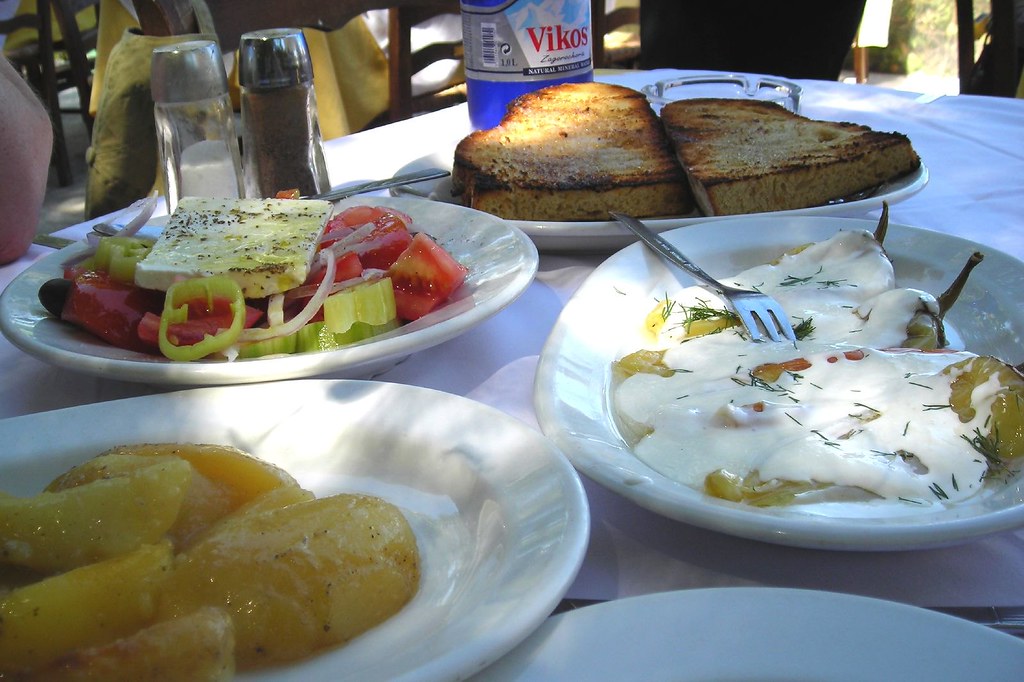 We were ready for lunch and we miraculously found Ksenios Zeus on the first try. The waiter recognized us from the night before, what a great memory! I have no memory for names or faces. When I worked retail a customer would ask me a question, I'd go look up the answer...and then realize I had no idea who I was looking for. We had a Greek salad, roasted pappers served cold and topped with a garlicky yogurt sauce, the oven potatoes, and of course their wonderful bread. At the end of the meal we both realized that we had each carefully planned our last bite of the meal. K chose potatoes, while I went for the bread. We were both satisfied with our respective plans. With water and Greek coffee for K, the total was 14.5E. Around $10USD for as good a meal as you can wish for. Astounding.
We were ready for lunch and we miraculously found Ksenios Zeus on the first try. The waiter recognized us from the night before, what a great memory! I have no memory for names or faces. When I worked retail a customer would ask me a question, I'd go look up the answer...and then realize I had no idea who I was looking for. We had a Greek salad, roasted pappers served cold and topped with a garlicky yogurt sauce, the oven potatoes, and of course their wonderful bread. At the end of the meal we both realized that we had each carefully planned our last bite of the meal. K chose potatoes, while I went for the bread. We were both satisfied with our respective plans. With water and Greek coffee for K, the total was 14.5E. Around $10USD for as good a meal as you can wish for. Astounding. Refreshed, we were ready to tackle the remaining tabs on our combined ticket. We were determined to visit everything. Leave no tab behind! We headed off to the Ancient Agora. It houses another wonderful, edited, accessible by the layperson museum, with some great statuary fragments outside, including this great Aphrodite. On site is the Church of the Apostles with some nice frescoes inside.
Refreshed, we were ready to tackle the remaining tabs on our combined ticket. We were determined to visit everything. Leave no tab behind! We headed off to the Ancient Agora. It houses another wonderful, edited, accessible by the layperson museum, with some great statuary fragments outside, including this great Aphrodite. On site is the Church of the Apostles with some nice frescoes inside.  The Ancient Agora's star feature is the Temple of Hephaestos, one of the best preserved temples of its type in Greece. Hephaestos was the patron god of metal-working, and some sources say Athena in her guise as patron of pottery and crafts was also honored here. The extant friezes depict the labors of Herakles, and you can see rivulets etched into them, presumably the result of acid rain. The Temple makes some really lovely photographs when the sky is as blue as the day we were there.
The Ancient Agora's star feature is the Temple of Hephaestos, one of the best preserved temples of its type in Greece. Hephaestos was the patron god of metal-working, and some sources say Athena in her guise as patron of pottery and crafts was also honored here. The extant friezes depict the labors of Herakles, and you can see rivulets etched into them, presumably the result of acid rain. The Temple makes some really lovely photographs when the sky is as blue as the day we were there.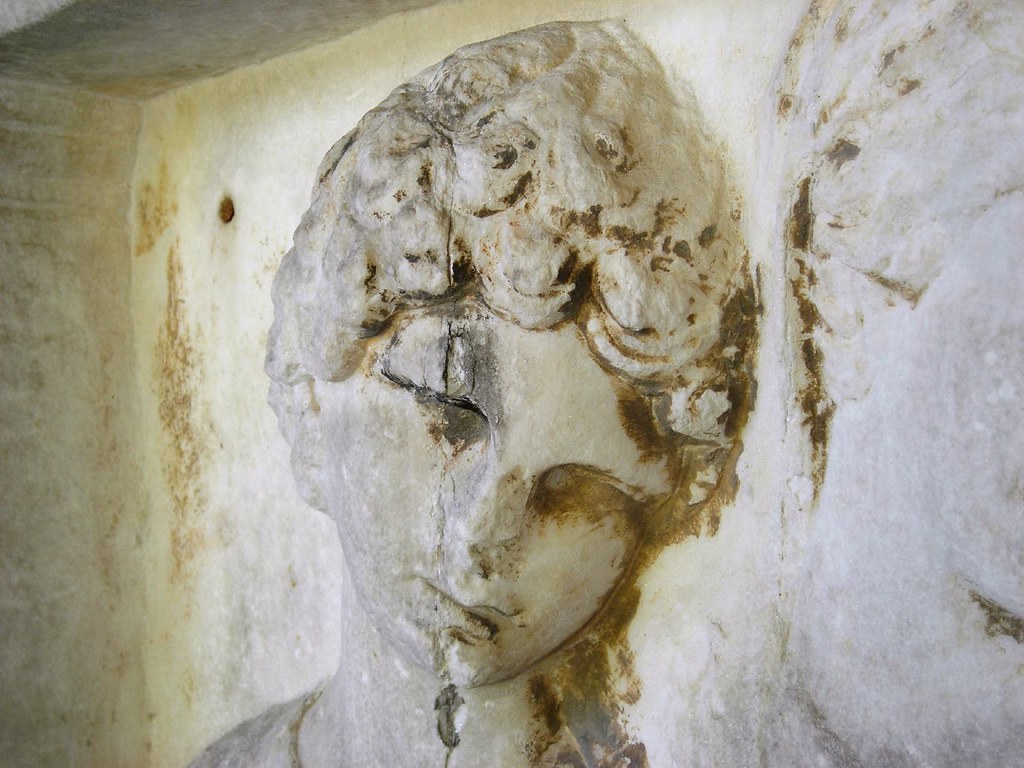 On to the Karameikos! The name means "ceramics"; at one point this was the potter's district. However, it is preserved and visited now as the cemetery of Athens. The road that ran through it was lined with memorial stele, stone slabs generally carved with the name of the deceased and with reliefs. The one at left depicts a young mother who has died and is bidding farewell to her child.
On to the Karameikos! The name means "ceramics"; at one point this was the potter's district. However, it is preserved and visited now as the cemetery of Athens. The road that ran through it was lined with memorial stele, stone slabs generally carved with the name of the deceased and with reliefs. The one at left depicts a young mother who has died and is bidding farewell to her child. 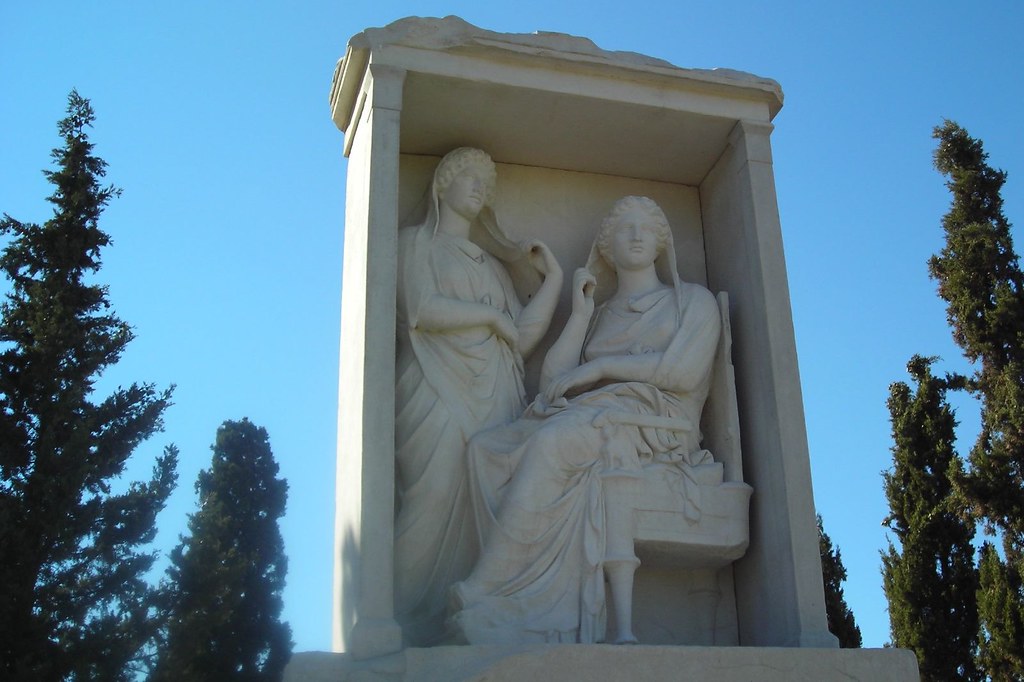 Fancier stele are more like a little house with fully articulated figures carved into it, as with the two sisters at right. The one in the photo is a cast that has been placed in situ. The on-site museum, which houses the original, describes the sisters as dreamy and already unconcerned with the affairs of this world.
Fancier stele are more like a little house with fully articulated figures carved into it, as with the two sisters at right. The one in the photo is a cast that has been placed in situ. The on-site museum, which houses the original, describes the sisters as dreamy and already unconcerned with the affairs of this world. 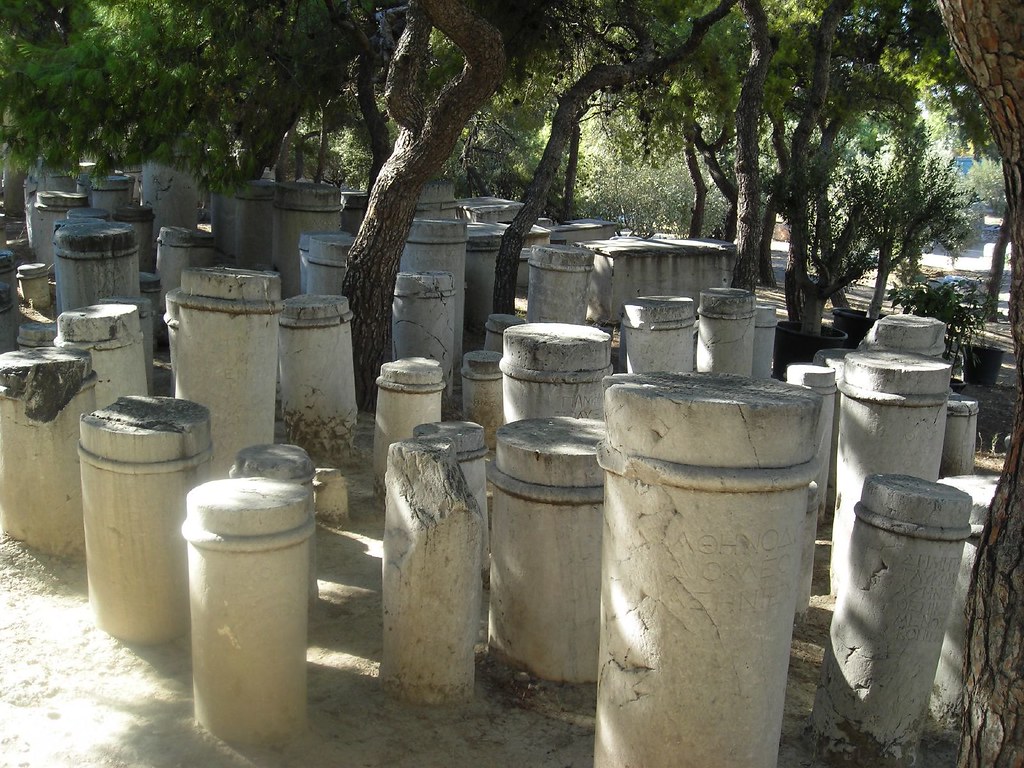 Periodically, decrees went out against fancy and expensive funeral markers. During those times, and I assume by poorer people no matter what was allowed, simple marble pillars inscribed with the name of the deceased were placed. These have been gathered up and clustered right outside the museum (saw them on the way to the bathroom, natch), which is an interesting sight.
Periodically, decrees went out against fancy and expensive funeral markers. During those times, and I assume by poorer people no matter what was allowed, simple marble pillars inscribed with the name of the deceased were placed. These have been gathered up and clustered right outside the museum (saw them on the way to the bathroom, natch), which is an interesting sight.At this point we are flagging. But we are determined to have all the tabs on the combined ticketpulled! Actually, we were already thwarted in that as they hadn't pulled our tab at Olympian Zeus. Curses! Somehow it didn't feel right to tear it off ourselves so at the end of the day our tickets still had one tab left. Anyway, our last site was the Roman Agora. We had a little trouble navigating to it, even though we later realized it is right up from the Karameikos.
The Romans (hence the name) built the Roman Agora to replace the ancient agora, I guess to make the city feel more Roman than Greek. It never really caught on and is quite small compared to the Ancient Agora. That could just be the effect of limited excavations, though.
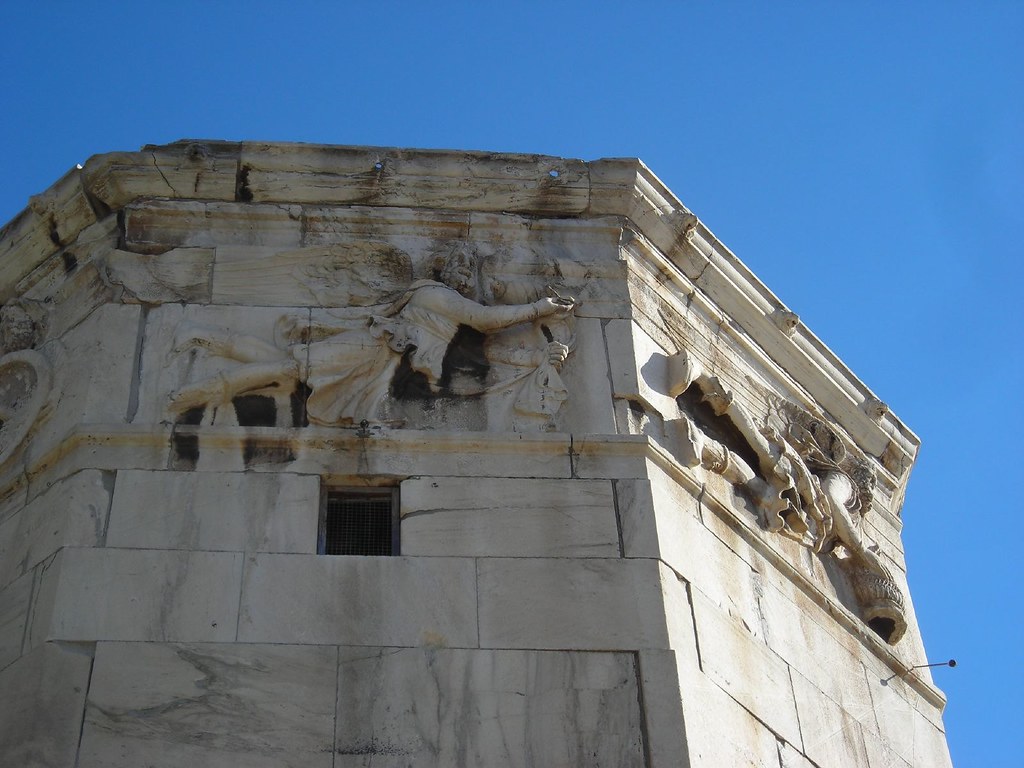 The most famous site at the Roman Agora is the Tower of the Winds, an octagonal tower with friezes depicting the eight winds. I'm not quite sure what the eight winds are; wikipedia says they are Boreas (N), Kaikias (NE), Eurus (E), Apeliotes (SE), Notus (S), Lips (SW), Zephyrus (W), and Skiron (NW). The Tower told time by the sun (again I'm unclear here--not sure whether the tower itself was a sundial or whether it had a sundial on it), and on cloudy days the water clock inside filled in.
The most famous site at the Roman Agora is the Tower of the Winds, an octagonal tower with friezes depicting the eight winds. I'm not quite sure what the eight winds are; wikipedia says they are Boreas (N), Kaikias (NE), Eurus (E), Apeliotes (SE), Notus (S), Lips (SW), Zephyrus (W), and Skiron (NW). The Tower told time by the sun (again I'm unclear here--not sure whether the tower itself was a sundial or whether it had a sundial on it), and on cloudy days the water clock inside filled in. 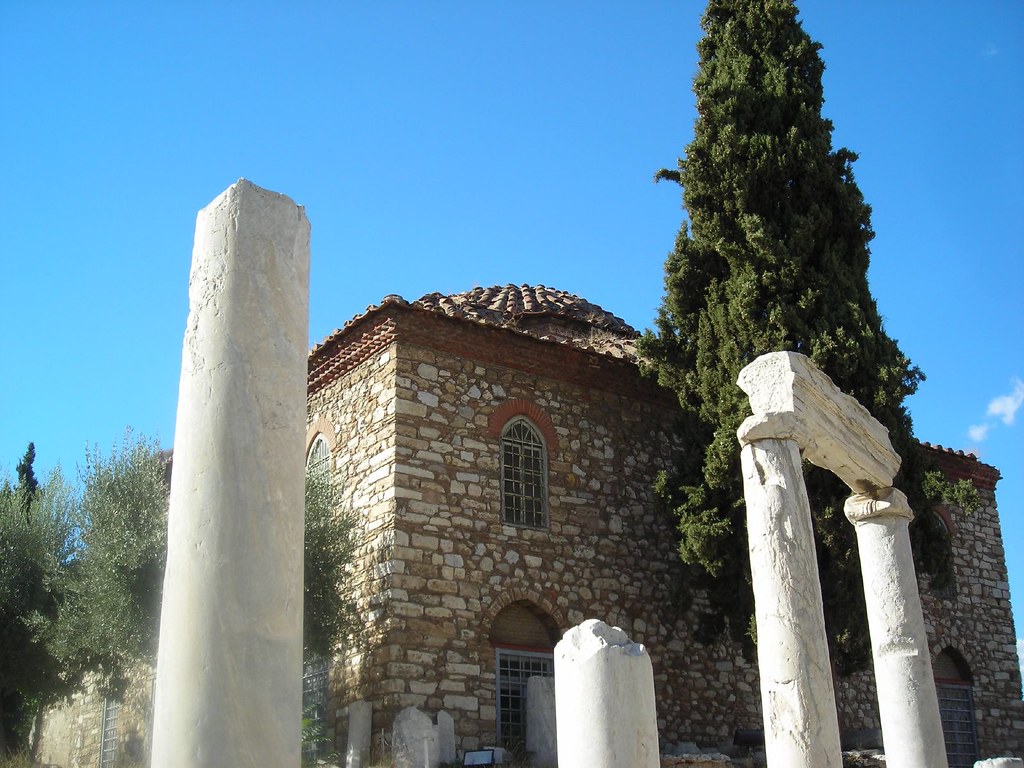 There is a mosque on the site of the Roman Agora, much abandoned and overgrown. We didn't get the chance to visit any mosques (other than Christian churches that had served time as mosques during the Turkish occupation), which was a bit of a disappointment to me.
There is a mosque on the site of the Roman Agora, much abandoned and overgrown. We didn't get the chance to visit any mosques (other than Christian churches that had served time as mosques during the Turkish occupation), which was a bit of a disappointment to me.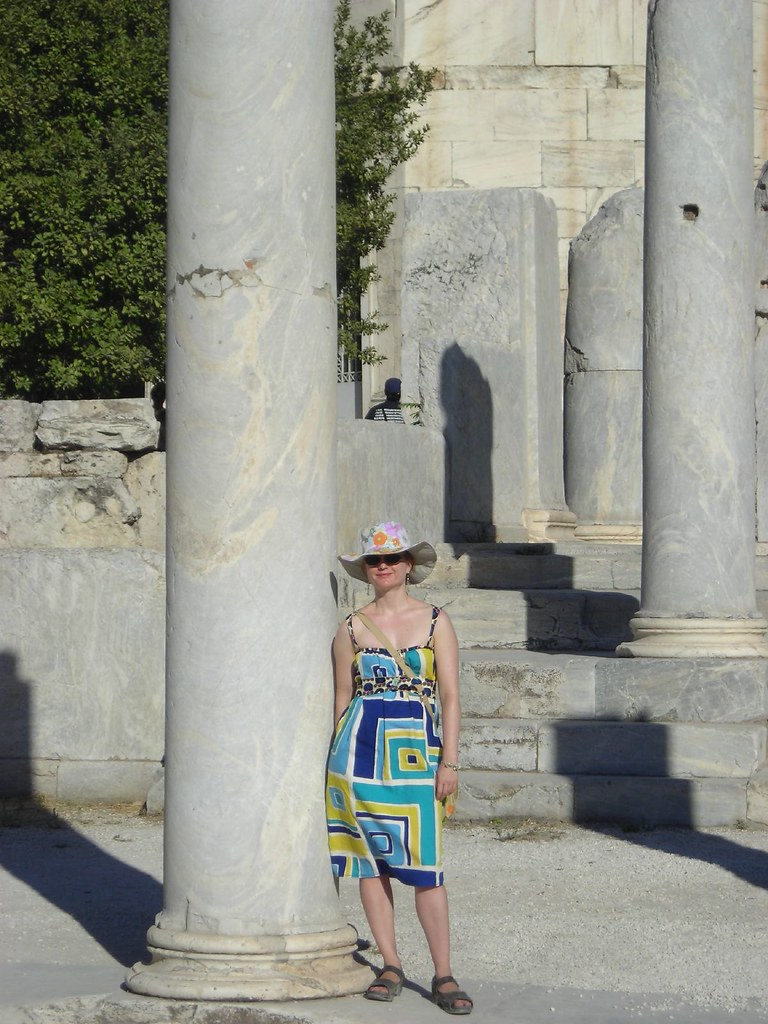 We were so tired here that we got a little hysterical and couldn't stop laughing. I had K take one last picture of me hanging out at an ancient column and we headed out, having conquered the combined ticket. As we exited the Roman Agora, our final site, I was forced to say, "Veni, vidi, vici," although a better motto would be "We came, we saw, we photographed."
We were so tired here that we got a little hysterical and couldn't stop laughing. I had K take one last picture of me hanging out at an ancient column and we headed out, having conquered the combined ticket. As we exited the Roman Agora, our final site, I was forced to say, "Veni, vidi, vici," although a better motto would be "We came, we saw, we photographed."We found our way around the Acropolis clockwise, a first for us. Even though it is quite easy and, well, the Acropolis is a landmark that's really hard to miss, somehow clockwise had eluded us. We stopped in a mini-mart, where I got 4 more postcard stamps and a Choco Magnum ice cream (about 4E total). At the hotel I realized that I had left the door hanger on "Please Do Not Disturb" rather than "Please Make Up Room." Oh well. I ate my melty Magnum ice cream, which is similar to a Drumstick in the US but approximately 1327% better.
It was only 6:30--and we had had a leisurely morning and not left the hotel until 10:30 or so. I'm going to blame our poor stamina showing on cumulative exhaustion. Plus, I was still sick. On the mend, but still sick. It is terrible to get a cold every time I travel, but on the bright side I have a ridiculously strong immune system. I eat a healthy vegetarian diet and am a fiend for the gym, so a cold that would fell a mere mortal merely gave me some misery for 3 or 4 days but didn't slow me down...much. I did nap that evening before showering for dinner.
We figured it would be ridiculous to go back to Zeus and we should try someplace new for dinner so we wandered Plaka. We found To Gerani/Scholarcheio, which had been recommended by my guidebook. It was crowded so we decided to give it a shot. It is a prix fixe meal for 24E for two for five dishes, wine, bread, water, and dessert. Instead of offering a menu, the waiters brings a big tray laden with about 12 prepared dishes, and you choose your food right off the tray. We got yiyandes (giant beans), horta (steamed wild greens, served cold), fried potatoes (also, unfortunately, served cold), meatballs, and unbreaded but possibly fried eggplant. It was very eh. The guidebook strikes out again. Dessert was farina cake.
Our entertainment for the evening was the valet. We were on the balcony overlooking the minuscule parking lot. The valet took cars and mysteriously secreted them away in the maze of Plaka after it was full. It was amazing to watch him casually manuever very expensive cars (saw the only SUV of the trip that night, and a BMW at that) into tiny spots. Then he had a glass of wine. Nothing like wine to aid in the parking of BMW SUVs in winding dark alleys just wide enough for the wandering cats of Athens to squeeze through.
You can see all my photos from Athens or all the photos from this trip to Greece if you'd like.
No comments:
Post a Comment